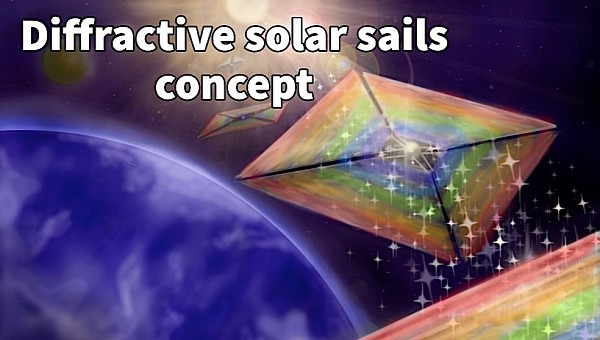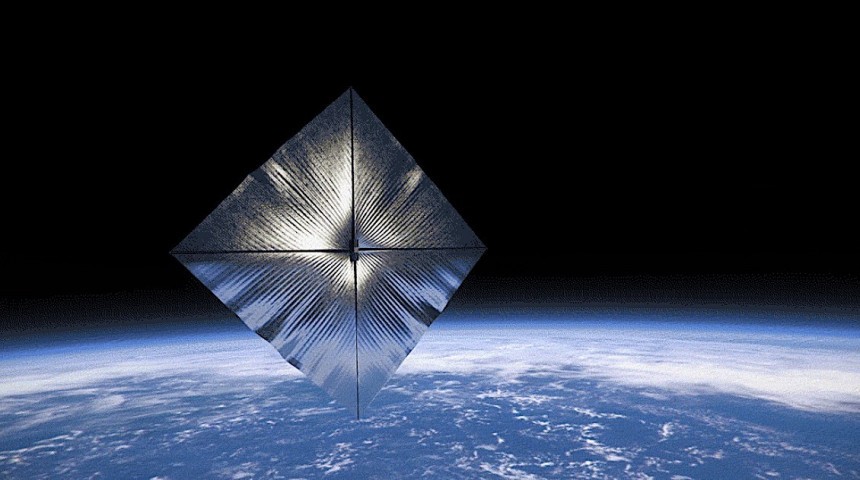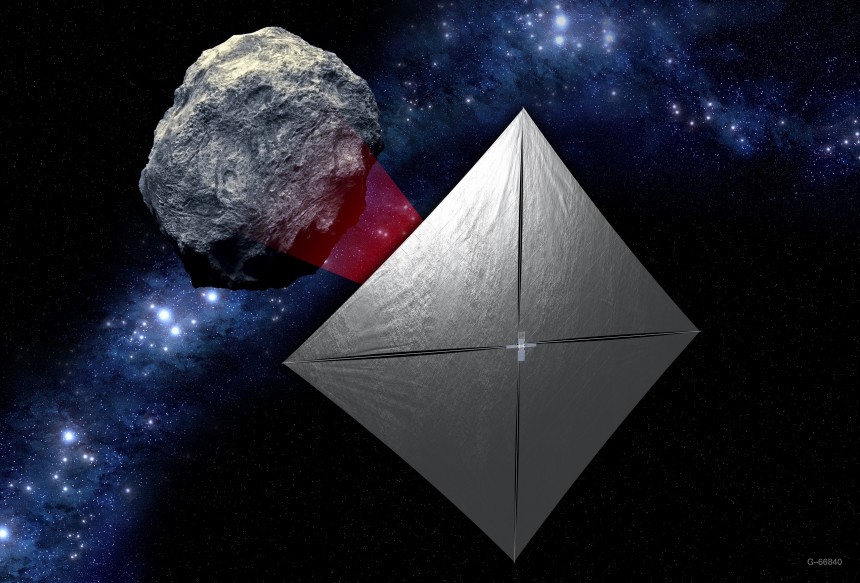For a number of years now NASA’s Innovative Advanced Concepts (NIAC) program has been the driving force behind some of space exploration’s craziest, most spectacular, and daring ideas born in the minds of those with an interest in this industry. From actual spaceships to new means of propulsion like the Diffractive Solar Sailing we’re here to look at now, these ideas might one day change not only our world, but also the solar system and, who knows, maybe even the galaxy.
NIAC has been established as a means for NASA to find and fund space-related technologies imagined by anyone, including people not directly involved with the organization. An important thing to note, before going deeper into the Diffractive Solar Sailing concept, is that although recognized and at times even funded, these ideas might never make it into the real world. They still make great reads, though, and are delicious food for imagination.
The Diffractive Solar Sailing is a project developed by the Johns Hopkins University’ s Applied Physics Laboratory and led by researcher Amber Dubill. It was selected as a NIAC award recipient last year, and unlike many other such projects that most of the time get stuck in Phase I of the program, it moved to Phase III – that’s a recognition this thing could have a significant impact on space exploration.
But what is Diffractive Solar Sailing? To address the elephant in the room first, that would be a type of solar sail. You know, the kind of rather simple technology that is used to harness the pressure exerted by sunlight against a large surface, with the goal of pushing a spacecraft through the void. Just like sailboats do with wind on the seas of our world, only, of course, in space.
Most of the ideas being researched in the field of solar sailing try to make the sails themselves reflective. Just like you’ve seen in movies, the surface of the sail is highly mirror-like, and that’s because it needs to reflect light off of its surface to generate forward motion for the hardware it's attached to.
Dubill’s idea however relies on the diffractive approach. Unlike reflection, which sends light back in inverted form, diffraction bends and spreads it. But why would this approach be better?
You see, reflective sails generally need to be extremely large (and thin) to be of some use for the purpose they’ve been created. Large because a lot of sunlight needs to be reflected at any given time to get a noticeable effect, and thin because of, well, mass, which needs to be kept as low as possible. Moreover, to push the spacecraft in the desired direction they need to be positioned in a specific way in relation to the sunlight falling on them.
Approaching solar sails from a diffractive perspective kind of eliminates some of those constraints in one go. When it comes to size, only small gratings of thin film (but a lot of them) would need to be used, ready to take advantage of light diffraction. This in turn would mean sunlight is more effectively used, and the spaceship carrying these gratings would not be hindered by the need to point its sail in a certain direction depending on where it needs to go. And it'll also create some spectacular rainbow-like light shows...
Needless to say, such an approach could open up a world of new possibilities, at least until something more akin to a proper warp drive gets here. And on that long list of possibilities is the chance to study the Sun of our system in closer detail than ever before.
Phase III of the NIAC program awarded Dubill and her team $2 million over two years to come up with a more solid proposition that could eventually turn into a NASA mission. That means we probably won’t get something tangible on this subject until next year, but we already know the initial details of that mission.
Humans have sent several missions to study the Sun, but most of them approached it sort of head-on. That’s because going high or low, over the star’s north and south poles, is a bit challenging with spacecraft that use conventional propulsion.
A ship equipped with a diffractive solar sail would have little problems doing that, though. In fact, Dubill imagines an entire constellation of such ships being deployed over the Sun’s poles, bringing us a better understanding of the celestial object that is without a question one of the main pillars of our existence. It could also help us make better predictions about space weather, an invisible force that’s impacting us on an ever-increasing scale.
Since NASA announced this idea moved on to Phase III we’ve had no word on the subject, but we’ll update this story as soon as we learn more. As for when a mission with this tech could depart, that’s too far off to even be considered.
The Diffractive Solar Sailing is a project developed by the Johns Hopkins University’ s Applied Physics Laboratory and led by researcher Amber Dubill. It was selected as a NIAC award recipient last year, and unlike many other such projects that most of the time get stuck in Phase I of the program, it moved to Phase III – that’s a recognition this thing could have a significant impact on space exploration.
But what is Diffractive Solar Sailing? To address the elephant in the room first, that would be a type of solar sail. You know, the kind of rather simple technology that is used to harness the pressure exerted by sunlight against a large surface, with the goal of pushing a spacecraft through the void. Just like sailboats do with wind on the seas of our world, only, of course, in space.
Most of the ideas being researched in the field of solar sailing try to make the sails themselves reflective. Just like you’ve seen in movies, the surface of the sail is highly mirror-like, and that’s because it needs to reflect light off of its surface to generate forward motion for the hardware it's attached to.
You see, reflective sails generally need to be extremely large (and thin) to be of some use for the purpose they’ve been created. Large because a lot of sunlight needs to be reflected at any given time to get a noticeable effect, and thin because of, well, mass, which needs to be kept as low as possible. Moreover, to push the spacecraft in the desired direction they need to be positioned in a specific way in relation to the sunlight falling on them.
Approaching solar sails from a diffractive perspective kind of eliminates some of those constraints in one go. When it comes to size, only small gratings of thin film (but a lot of them) would need to be used, ready to take advantage of light diffraction. This in turn would mean sunlight is more effectively used, and the spaceship carrying these gratings would not be hindered by the need to point its sail in a certain direction depending on where it needs to go. And it'll also create some spectacular rainbow-like light shows...
Needless to say, such an approach could open up a world of new possibilities, at least until something more akin to a proper warp drive gets here. And on that long list of possibilities is the chance to study the Sun of our system in closer detail than ever before.
Humans have sent several missions to study the Sun, but most of them approached it sort of head-on. That’s because going high or low, over the star’s north and south poles, is a bit challenging with spacecraft that use conventional propulsion.
A ship equipped with a diffractive solar sail would have little problems doing that, though. In fact, Dubill imagines an entire constellation of such ships being deployed over the Sun’s poles, bringing us a better understanding of the celestial object that is without a question one of the main pillars of our existence. It could also help us make better predictions about space weather, an invisible force that’s impacting us on an ever-increasing scale.
Since NASA announced this idea moved on to Phase III we’ve had no word on the subject, but we’ll update this story as soon as we learn more. As for when a mission with this tech could depart, that’s too far off to even be considered.









